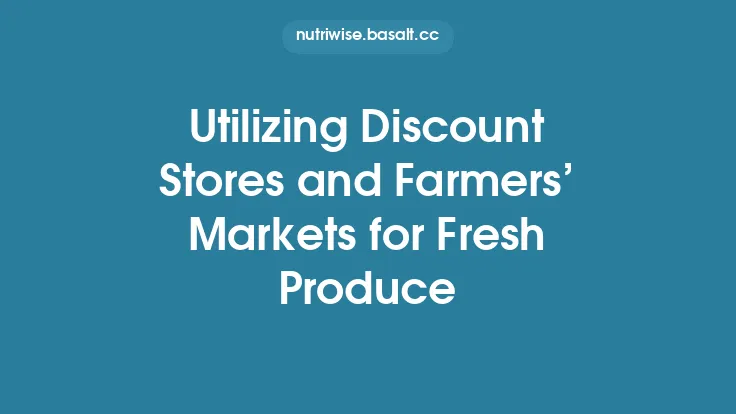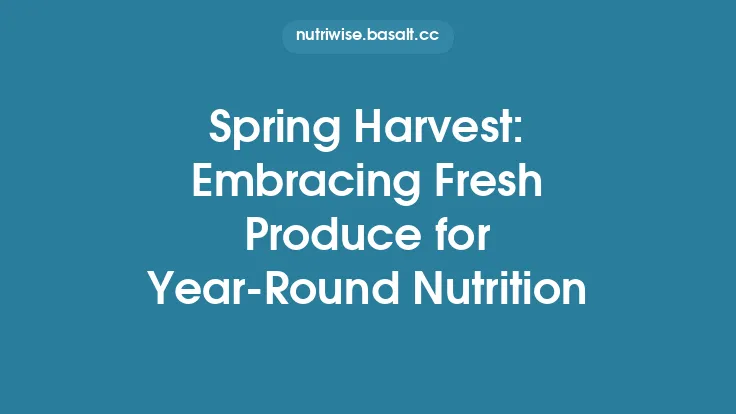Fresh produce is the cornerstone of a diet rich in vitamins, minerals, and phytonutrients. While the nutritional value of fruits and vegetables is often highlighted in broad “micronutrient‑rich foods” guides, the real challenge lies in selecting the right items at the point of purchase and handling them in a way that preserves their micronutrient bounty. This article walks you through the science and practicalities of choosing fresh produce that delivers optimal micronutrient benefits—from farm to table.
Why Freshness Matters for Micronutrients
Micronutrients are chemically active compounds that can degrade, transform, or leach out of plant tissues after harvest. The rate and extent of these changes depend on several factors:
| Micronutrient | Primary Degradation Pathway | Typical Half‑Life Post‑Harvest* |
|---|---|---|
| Vitamin C (ascorbic acid) | Oxidation (exposure to O₂, light, heat) | 3–7 days at 4 °C |
| Folate (vitamin B9) | Oxidative breakdown, enzymatic conversion | 5–10 days at 4 °C |
| Carotenoids (β‑carotene, lutein) | Isomerization & oxidation | 10–14 days at 4 °C |
| Polyphenols (flavonoids, anthocyanins) | Enzymatic oxidation, polymerization | 7–21 days, varies by fruit |
| Minerals (K, Mg, Fe, Zn) | Generally stable, but can leach during washing | Minimal loss (<5 %) |
\*Values are approximate and depend on storage temperature, atmosphere, and produce type.
The takeaway: the fresher the produce, the higher the retained levels of most vitamins and phytonutrients. Minerals are more resilient, but even they can be lost through improper washing or prolonged storage.
Assessing Visual and Tactile Cues
Your senses are powerful tools for gauging freshness. Below are the most reliable indicators for common produce categories.
| Produce | Visual Cue | Tactile Cue | Micronutrient Implication |
|---|---|---|---|
| Leafy greens (spinach, kale) | Deep, uniform color; no yellowing or wilting edges | Crisp, firm leaves; no slimy or rubbery texture | Retains high levels of vitamin K, folate, and lutein |
| Berries (strawberries, blueberries) | Bright, uniform hue; no mold spots | Slightly firm but yielding to gentle pressure | Preserves vitamin C and anthocyanins |
| Citrus (oranges, lemons) | Smooth, glossy skin; no soft spots | Weighty for size; firm rind | Maintains vitamin C and flavonoids |
| Root vegetables (carrots, beets) | Smooth, unblemished skin; no cracks | Firm, dense when squeezed | Keeps beta‑carotene (carrots) and betalains (beets) |
| Tomatoes | Uniform red (or appropriate variety color) with no green shoulders | Slight give on gentle pressure, not mushy | Holds lycopene and vitamin C |
Key tip: Look for “snap” or “crack” resistance in leafy greens and root vegetables—these indicate intact cell walls, which correlate with higher micronutrient retention.
Understanding the Impact of Harvest Timing
Plants synthesize micronutrients in response to environmental cues. Harvesting at the right physiological stage maximizes nutrient density.
- Peak Vitamin C: Typically reached just before full ripeness in many fruits (e.g., bell peppers, strawberries). Harvesting slightly early can preserve higher vitamin C, but may sacrifice flavor.
- Maximum Carotenoids: In carrots and sweet potatoes, carotenoid accumulation continues as the root matures. Harvest at full size for optimal β‑carotene.
- Folates & B‑Vitamins: Leafy greens exhibit peak folate levels during rapid leaf expansion (early to mid‑growth). Harvesting after the plant begins senescing reduces folate content.
When buying from a farmer’s market or CSA, ask the grower about the harvest window. Many small‑scale producers time their pick to coincide with peak nutrient levels, especially for specialty crops.
Soil Health and Its Influence on Micronutrient Profiles
The mineral composition of the soil directly dictates the mineral content of the produce grown in it.
- pH Balance: Slightly acidic soils (pH 6.0–6.5) improve the availability of iron, manganese, and zinc, which are essential for enzyme function in plants.
- Organic Matter: High organic matter enhances cation exchange capacity, allowing better uptake of potassium, magnesium, and calcium.
- Micronutrient Amendments: Soils deficient in selenium or iodine can be supplemented, leading to measurable increases in those micronutrients in crops like broccoli and kale.
If you have the option to choose produce from farms that practice soil testing and amendment, you are more likely to receive vegetables with higher mineral densities.
Choosing the Right Source: Farm, Farmers Market, CSA, and Grocery Store
| Source | Typical Freshness | Micronutrient Advantages | Considerations |
|---|---|---|---|
| On‑farm stand | Same‑day harvest | Highest vitamin C, carotenoids, and phytonutrients | Limited variety; may require travel |
| Farmers market | 1–3 days post‑harvest | Strong micronutrient retention; often diverse cultivars | Variable quality; need to assess each vendor |
| CSA (Community Supported Agriculture) | Weekly deliveries, often within 24 h of harvest | Consistent freshness; seasonal variety encourages diverse micronutrient intake | Subscription commitment; may receive unfamiliar varieties |
| Grocery store (conventional) | 5–10 days post‑harvest (often longer for imported produce) | Adequate minerals; vitamins may be reduced | Longer supply chain; potential for nutrient loss during transport and storage |
Practical advice: Prioritize local sources when possible, especially for highly perishable, vitamin‑rich produce (berries, leafy greens, tomatoes). For staples like potatoes or onions, grocery store options are acceptable because their micronutrient profile is less sensitive to short‑term storage.
Seasonality and Variety Selection
Even within a single fruit or vegetable, different cultivars can vary dramatically in micronutrient content.
- Tomatoes: “Sun Gold” cherry tomatoes contain up to 30 % more lycopene than standard beefsteak varieties.
- Carrots: Purple carrots have higher anthocyanin levels, while orange carrots are richer in β‑carotene.
- Apples: “Granny Smith” retains more vitamin C than “Red Delicious” after storage.
When selecting produce, ask about the specific variety and its known nutrient profile. Seasonal availability often aligns with peak nutrient density because the plant has completed its natural growth cycle without artificial ripening.
Storage Practices to Preserve Micronutrients
Even after purchase, proper storage can extend the micronutrient window.
- Temperature Control
- Refrigeration (0–4 °C): Ideal for leafy greens, berries, and most fruits. Slows enzymatic oxidation of vitamin C and polyphenols.
- Room Temperature (15–20 °C): Suitable for bananas, tomatoes, and stone fruits that benefit from continued ripening.
- Atmospheric Modification
- Modified‑Atmosphere Packaging (MAP): Reduces O₂ and increases CO₂, slowing vitamin C loss. Look for “low‑oxygen” packaging on some produce.
- Paper Bags for Ethylene‑Sensitive Items: Store apples separately to prevent premature ripening of ethylene‑sensitive vegetables.
- Moisture Management
- Leafy Greens: Store in perforated plastic bags with a damp paper towel to maintain turgidity without excess moisture that encourages decay.
- Berries: Keep in a single layer on a paper towel, loosely covered, to absorb excess moisture and prevent mold.
- Minimal Washing Before Storage
- Wash only before consumption. Water can accelerate leaching of water‑soluble vitamins (e.g., vitamin C, folate) and promote microbial growth.
- Rapid Consumption
- Aim to consume high‑vitamin C produce within 3–5 days of purchase. Carotenoid‑rich vegetables retain quality longer (up to 2 weeks) if kept cool and dark.
Transport and Handling Considerations
The journey from farm to your kitchen can be a critical period for nutrient loss.
- Mechanical Damage: Bruising ruptures cell membranes, exposing enzymes that degrade vitamins. Choose produce without dents or soft spots.
- Temperature Fluctuations: Repeated warming and cooling cycles accelerate oxidative reactions. If you must travel a long distance, use insulated bags or a cooler.
- Time in Transit: For imported produce, consider the “food miles” concept. While not a direct measure of nutrient loss, longer transit often correlates with older harvest dates.
If you purchase produce that has been shipped long distances, prioritize items that are naturally more stable (e.g., root vegetables, squashes) and supplement with locally sourced, highly perishable items for vitamin‑rich variety.
The Role of Organic and Conventional Practices
Both organic and conventional farms can produce micronutrient‑dense vegetables, but the cultivation method influences certain aspects.
- Soil Micronutrient Availability: Organic farms often rely on compost and cover crops, which can improve soil organic matter and micronutrient availability. Studies have shown modest increases (5–15 %) in iron, zinc, and magnesium in organically grown leafy greens.
- Pesticide Residues: While not directly a micronutrient issue, lower pesticide residues can reduce the need for extensive washing, preserving water‑soluble vitamins.
- Synthetic Fertilizers: Conventional farms may use nitrogen‑rich fertilizers that boost leaf mass but can dilute micronutrient concentration (the “growth dilution” effect). However, targeted micronutrient fertilization can offset this.
Bottom line: Choose the production system that aligns with your values and local availability, but always apply the freshness and handling principles outlined above to maximize micronutrient intake.
Practical Tips for Selecting Specific Produce Groups
Leafy Greens (Spinach, Kale, Swiss Chard)
- Look for: Deep, vibrant color; no yellowing or wilting.
- Touch: Firm stems, crisp leaves.
- Tip: If stems are thick, they may indicate older leaves with reduced folate. Trim the base and store with a damp paper towel.
Cruciferous Vegetables (Broccoli, Brussels Sprouts, Cabbage)
- Look for: Tight florets, compact heads, no yellowing.
- Touch: Firm buds; no soft spots.
- Tip: Small, tightly packed heads often have higher glucosinolate and vitamin C levels.
Root Vegetables (Carrots, Beets, Sweet Potatoes)
- Look for: Smooth skin, uniform color, no cracks.
- Touch: Heavy for size, firm.
- Tip: For carrots, orange intensity correlates with β‑carotene; purple varieties add anthocyanins.
Berries (Strawberries, Blueberries, Raspberries)
- Look for: Uniform color, no mold, intact caps.
- Touch: Slight give, not mushy.
- Tip: Buy in small quantities to ensure rapid consumption; store on a paper towel in the fridge.
Citrus (Oranges, Grapefruits, Lemons)
- Look for: Bright, glossy skin; no soft spots.
- Touch: Heavy for size, firm rind.
- Tip: Slightly soft spots can indicate higher juice content but also faster vitamin C loss.
Tomatoes
- Look for: Uniform color, no green shoulders (unless a specific variety).
- Touch: Slight give when gently pressed.
- Tip: Heirloom varieties often have higher lycopene; store at room temperature to finish ripening, then refrigerate if not used within a few days.
When to Trust the Senses vs. Scientific Data
Your senses are excellent for spotting obvious defects, but they cannot quantify micronutrient levels. Use sensory assessment to filter produce, then apply the scientific principles above (harvest timing, variety, storage) to optimize nutrient intake.
- Senses first: Reject any produce with visible decay, off‑odors, or abnormal texture.
- Science second: Choose varieties known for higher nutrient density, prioritize local and recently harvested items, and store them correctly.
By combining both approaches, you achieve a pragmatic, evidence‑based strategy for maximizing micronutrient intake from fresh produce.
Conclusion: Making Informed Choices for Micronutrient‑Rich Produce
Selecting fresh produce that delivers the highest possible micronutrient benefit is a multi‑step process that extends beyond simply “buying green.” It involves:
- Understanding how freshness, harvest timing, and soil health affect nutrient levels.
- Using visual and tactile cues to identify truly fresh items.
- Choosing the right source—local farms, farmers markets, or CSAs—where possible.
- Recognizing the impact of cultivar and seasonality on specific micronutrients.
- Implementing storage, transport, and handling practices that preserve vitamins, minerals, and phytonutrients.
- Balancing personal values (organic vs. conventional) with evidence‑based nutrient outcomes.
By applying these guidelines, you can confidently navigate the produce aisle, bring home vegetables and fruits that are not only delicious but also packed with the vitamins, minerals, and antioxidants your body needs for optimal health. The journey from farm to table becomes a purposeful act of nutrition, turning everyday meals into powerful vehicles for micronutrient wellness.





